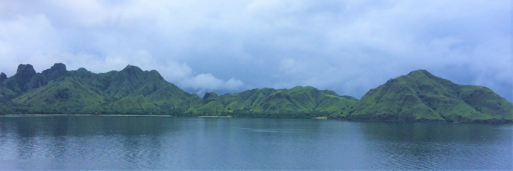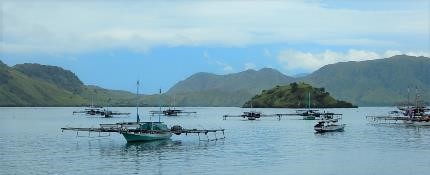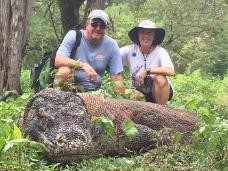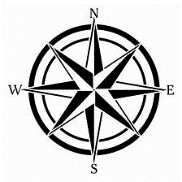After leaving Australia we turned towards Indonesia, easily one of the most intriguing destinations on earth. But coming into the port of Komodo Island (located between the islands of Sumbawa and Flores, in the eastern part of the Indonesian archipelago) feels like arriving on an entirely different planet. Stepping out onto the deck in the morning, the landscape in front of us stopped us in our tracks and took our breath away. The lush green majestic mountains were stunning. And the early morning mist added to its intrigue.


It’s hard to image that such a beautiful place is home to such an ugly beast; the Komodo Dragon. This island is home to roughly 5,700 dragons who roam freely. Growing to lengths of almost 10 feet, this intimidating giant lizard’s saliva contains a venom that will kill their prey, even if their jaws don’t do the trick. For safety reasons, any visit to shore must be accompanied by a Park Ranger.
Our day begins by tendering to shore for a walking tour of the small, forlorn fishing village, home to about 1500 locals. With no infrastructure, their meager homes are built from bamboo, cement, tarps, tin sheets; whatever seems available. Their homes are also stilted to safeguard against the dragons. To this point, we saw one goat dying along the side of the path. It had been bitten by a dragon but managed to escape its grasp and limped into the village. Many goats, chickens, stray cats and dogs wander aimlessly amongst the muddy paths and windblown trash strewn about. Our group of about 20 passengers are immediately surrounded by the barefoot village children, begging for money as they hold their primitively carved wooden dragons for sale. These children are as tenacious as hornets on the attack, pulling on your elbows and shirts. One child eyed a ball point pen hanging from my backpack and was practically in tears pleading for it. I gladly donated it, only to have the rest of the pack circle me for more. I was sad that I hadn’t been better prepared by bringing a supply of useful giveaways that they welcome (pencils, toothbrushes, school supplies of any kind, etc). One guest did bring a bag of saved “pillow chocolates” from the ship. The instant gratification evaporated quickly as each child popped the chocolate into their mouths; each of the wrappers scattering to the ground like confetti. We walked by their ‘hospital’, a one-room corroded building. Then onto their school, featuring two open-air buildings and a hodgepodge of grimy chairs and desks.
We boarded a junk-style boat for a 30-minute ride over to the Pink Beach, which gets its remarkable hue from tiny pieces of dead red corals that mix with the white sand. We snorkeled its pristine reefs, home to abundant marine life and more than 1,000 species of tropical fish. Afterwards, we head over to the Komodo National Park to watch and snap photos of the dragons, Timor deer and water buffalo in their natural habitat. Our Park Ranger urged us to position ourselves for this photo. He convinced us that this particular dragon had recently eaten and was sleeping it off. I’m glad he was right, because the Rangers only carry forked walking sticks as protection. In hindsight, I don’t think I’d do that again! The Komodo National Park is a UNESCO world heritage site, but clearly a land forgotten and untamed.

Next stop: Beautiful Bali ! We dock in the small village of Benoa, located on the southeastern coast. A charming fishing village, with calm waters and beautiful while-sand beaches and meandering walkways. Our Dining Room Steward who is from Bali, offered us a private tour with his Uncle Yeoman for the entire day. It was great to have “family” taking us around to see the sights and experience the essence of Bali. Within its magnificent landscape of valleys and volcanoes, sit mystical temples that date back centuries. The peaceful Balinese people are extremely devout, and life on the island revolves around prayers, ceremonies and thousands of temples. And artisans! There are a wide variety of artistic painters (mostly acrylic or oil), wooden carvers (think giant, intricately carved items like sculptures, tables, doors, buddhas, etc), batik fabric crafters, gold and silver jewelry craftsman, etc. Which results in a profusion of items for sale that seems to go on for miles.
We visited and walked among their iconic terraced rice fields. The green on green colors were a feast for the eyes. The locals have also found a fun way to make a few extra dollars with their giant swings that allow you to soar over the steep, terraced drop offs.
While in Bali, we also drank their rare “Luwak” coffee, touted as the most exotic, rich, smooth coffee of Bali. Yes, it is better known as ‘monkey butt coffee’. You may have heard of it? Producers of the coffee beans argue that their process may improve coffee through two means; selection – the animals choosing to eat only certain cherries – and digestion – biological or chemical reactions in the animal’s intestines, altering the composition of the coffee cherries. Once the monkey poops out the beans, they are cleaned (sanitized), roasted and ground. If you did not know about the process, you would consider this was pretty good coffee! Bali was also the place we found a unique Pringles flavor: Salt & Seaweed. Didn’t try that. The coffee was adventuresome enough!
When visiting countries via cruise ship, we’ve seen a variety of port methods. Sometimes docking right up to a city quay wall, or boarding shuttle buses through huge industrial ship yards, or maybe tendering in by small boats from the mother ship. Sometimes disembarking via the gangway to the pier, or through modern ‘jetways’ into a cruise ship terminal. Often, we are greeted by a local troupe playing indigenous music and/or performing their traditional costume and dance. And then there is Semarang, Java. We were completely surprised and humored that this Indonesian troupe was playing country western music. Their exuberant rendition of Johnny Cash’s “Ring of Fire” was noteworthy. (Note to Ken L. at HJ…. you would have loved it!).
Semarang is located on the central, northern seaboard of Java, part of Indonesia. A fairly industrial port and sister port to Jakarta. Semarang offers an eclectic mix of cultures. First inhabited by the Chinese in the 15th century, and later to the Dutch East India Company, Java has played host to many different occupants due to its strategic location along major trade routes. Old government buildings, like Lawang Sewu (or more commonly known as The Thousand Doors) clearly display a strong Dutch influence. And food also plays into the crazy mix of heritages. Curries, milkfish dishes and chicken feet are all wildly popular. Narrow residential alleys give way to bustling outdoor food courts with their mingled aromas.
Here’s something different: photo requests from strangers. The first time was by a young mother, her toddler son and grandmother. At first, I thought she was asking me if I would take a picture of them with her camera. When I reached for her camera, she indicated that she wanted Tom and me in the photo. Initially our senses went on high international alert, but as explained by one of our ship stewards who is from Java, Indonesians (especially Indonesian women and children) find light-haired people –called “bule”– a pleasant novelty and even good luck. It is a treasure to get a picture taken with a bule, and we had several additional requests like this throughout India as well. Weird-
The oppressive heat and humidity that has followed us since Darwin continues as we arrive in cosmopolitan Singapore for two days. Such a modern, diverse and clean city. Clean, as in spotless… you will be arrested if you have chewing gum! And streamlined transportation via their subway or Hop On/Hop Off Buses make it a snap to get around to all the interesting neighborhoods like Little India, Clarke Cay, Chinatown and Dhoby Ghaut, each with their own vibe, foods, music and ethnic apparel. There are also tons of interesting places to visit, such as the infamous Long Bar at the Raffles Hotel (home of the Singapore Sling), the Singapore Flyer Ferris wheel, the architectural spectacle of the Marina Bay Sands Hotel and its surrounding campus, as well as Gardens by the Bay, where a spectacular light show occurs nightly for free. Our 2 days here flew by!
With Singapore in our wake, the next several stops of our journey will require a sharpened alertness and heighted preparedness in ports. Shore visits will be void of any jewelry or purses, with under-garment money belts or wallets tucked into front zippered pockets. Hand sanitizer and your own toilet paper complete the list, other than being constantly vigilant to your surroundings. No paranoia, just the reality of that part of the world.
Heading west, we come to Colombo, Sri Lanka. We set out to wander the circumference of Beire Lake, the Lotus Tower, and Colombo’s many open-air markets, including a floating market. Exotic fruits and vegetables like Jack Fruit, Durian, various hot peppers and fresh spices including cinnamon. And fantastic, cheap prices on everything. Nice quality T-shirts are only $3. A full day ashore including t-shirts, a skirt, several souvenirs, lunch and tuk-tuk rides cost us only $46. The exchange rate is 175 Rupees to 1 US$, so we felt like ‘rich’ with such a thick stack of Rupees in our pocket. Easy to afford a tasty chicken curry lunch on the beach at the classy Galle Face Hotel, built in 1864. Though it did give pause to see that adjacent to the hotel, was a manned military sentry tower on active watch. But in the coming weeks would see why they stand watch. Since our visit there, we were shocked to learn about the tragic terrorist bombings on Easter Sunday. We are terribly saddened to think of the warm, peaceful people we met there have been subjected to these senseless, murderous acts.
We celebrated Tom’s birthday while at sea, somewhere between Sri Lanka and India. The Filipino Dining Room Stewards ensure that every birthday is a big deal by singing their heritage birthday song. Unlike the cheesy, annoying birthday song singing at a TGIF Fridays for instance, the Filipino celebration song is well respected and embraced by all passengers and crew, who are enthusiastic to join in. And of course, cake!
Cochin, India is known locally as the Venice of the East, given all its inland waterways. We hired a Tuk-Tuk and driver; $25 for 4 hours. Apparently, an English-speaking driver was an option we overlooked. Or I should say, English beyond “Good tour for $50” and required haggling thereafter. Nevertheless, we enjoyed our drivers limited English and between the 3 of us, we got by nicely. He took us on a tour to see the many churches and temples, local open-air meat and fish markets, and their ancient central laundry center known as dhobi ghat. For 18 to 20 hours each day, a small army of workers flog, scrub, dye and bleach clothes in concrete wash pens, dry them on ropes, neatly press them and transport the garments to different parts of the city. How one gets their laundry back is a mystery as apparently hotels, hospitals and individuals send their laundry here for washing, and then its returned to the owner without loss.
Cochin is also known for their tent-like Chinese fishing nets; nets that are stationary installations along the shoreline. Huge wooden structures hold horizontal nets of 50-60 feet upon structures that are least 30 feet high. They are cantilevered, with the outstretched net suspended over the sea. Large stones suspended from ropes serve as counterweights at the other end. Each installation is operated by a team of up to six fishermen. This way of fishing is unique to the area, but was originally introduced by Chinese explorers, hence their name.
Mumbai (Bombay), India – A city at full volume: colors, smells, sounds, sights, tastes. Even on a ‘quiet’ Sunday that we were there. Endless markets and bazaars go on for miles. Textiles, produce, apparel, etc. And tons of cinemas and theaters. India is crazy about movies and shows. Their favorite genre is Bollywood and a local troupe even provided us with an evening Show on board. We saw all the recommended tourist sites; the Fort area, the iconic Gateway to India, and the elaborate architecture of their Victoria Terminus Train Station, which efficiently transports 6 million people EACH day! We visited the infamous Taj Hotel for a ubiquitous Bombay Gin martini, then took a tuk-tuk the swanky Marina Drive, an upscale business/residential area, to hang out at the contemporary Oberon Hotel. Here, we came across a stone memorial remembering those 150 people who were killed in 2008 during a Pakistani terror attack. Terrorists sieged the train station, the Taj and Oberon hotels before they were stopped. Even though recent years have been peaceful, it seems strife is never far away in this part of the world. Which seems a good segue for my next section on piracy-
Anti-Piracy Precautions – A memo awaited us in our cabin with regards to our upcoming transit of the Indian Ocean towards Oman, considered a High-Risk Area. While there has been a significant decrease in pirate incidents in the past few years, the Captain and her ship would be taking the following precautions:
- The m.s. Amsterdam had already commenced reporting to UKMTO (United Kingdom Maritime Trade Organization) in Dubai. The UKMTO coordinates all the coalition warships in the area assigned to anti-piracy operations. We would be tracked during our transit and although we may not see them, warships are not far away.
- We have 4 LRADs (Long Range Acoustic Devices) rigged, manned and ready for immediate use.
- We have charged water hoses ready for use on both sides of the Lower Promenade Deck.
- A close radar watch will be kept on the Bridge
- We have extra Security Guards that will be rotating a 24-hour anti-piracy watch
- We will be making high speed, as always is a good deterrent.
- In the unlikely event of an attempted boarding, or even if we are suspicious of a vessel, you will hear an alarm and announcement. Upon hearing that, you are asked to move out of your Staterooms and stay in corridors or an interior space. Stay away from windows and doors. Sit down, as any maneuver attempted may result in heeling of the ship, as we will be moving at high speed, capable of 25 knots.
We made a hasty, but peaceful passage between India and Oman, though everyone maintains an acute sense of awareness, which will continue until we pass through the Suez Canal in another few days’ time.
Muscat, Oman – Muscat’s position on the Arabian Sea, surrounded by mountains is dramatically beautiful. The ornate Arabian architecture stands out starkly against the backdrop of rugged desert mountains. Clean and white and arid. The city’s many well-preserved forts and palaces are a glimpse into its military past and development as an Islamic nation. A modern Arab sultanate, Muscat has grown rapidly through petroleum wealth and it’s easy to see that influence in the many upscale shopping malls offering luxury brands and decadent resorts. As we arrive in the harbor, we can openly see the Sultans mansion and his two yachts, each over 200 feet long. In order to explore the city’s vast area of 1400 sq. miles, we opted for a Hop On/Hop Off bus in order to cover the most ground. While female tourists do not need to wear a burka, appropriate attire is required, ensuring that legs are covered. Old town Muscat has its fascinating Souk (market) with narrow, twisting alleyways. It would be impossible to cram any more into this eye-popping hodge podge of fabrics, jewelry, cooking utensils, backpacks, apparel, incense, tea, and the list goes on. The New Muscat area is modern with high end resorts and posh residences along the immaculate beach, boardwalk and parks. Needing to rehydrate, we ordered two of their specialties: a spicy lemon mint drink and mango juice. Several times a day, the call to prayer is sounded over city-wide loud speakers; the eerie sing-songy chant of Islam is heard through the hot haze of desert sand blowing in the wind.
We continue our tour of Arabic states, arriving in Al’Aqaba, Jordan, linked to the legend of Lawrence of Arabia and the famous 1962 film. Jordan has been inhabited for the past 6,000 years and is home to many historic sites and natural wonders. It is from here that quite a few fellow passengers are visiting adjacent temples and tombs at the UNESCO World Heritage Site of Petra, and its well-known Treasury (seen in Indiana Jones movies) and Wadi Rum’s petroglyphs and rock formations. Since we preferred to see what lays in front of us first, we opt to explore the city of Al’Aqaba, as well as get in some snorkeling in this sea-side oasis in the desert. We are pleasantly surprised at how clean and friendly this walkable town is. Once again, we find a traditional souk (marketplace), in which winding, narrow, covered alleys are there to easily get lost in. It’s all the usual stuff: fabrics, pots and pans, incense burners, gold and silver items, burkas, frankincense and myrrh, Arabian head towels, and on and on… Since Al’Aqaba is situated on the Red Sea which is known for its exceptional underwater wonders, we are anxious to get back into the water. We boarded the motor yacht, “Baraka”, with 6 other passengers and 4 crew for a sunny afternoon just off the coast to explore pristine coral reefs and clear, chilly waters. We were surprised at how cold the water was, since we are surrounded by hot, hot desert. Only a few of us braved the water temperature. Afterwards, we were treated to a delicious grilled lunch of fresh fish and chicken, salad, hummus and pita before motoring back to port.
The Suez Canal, is a sea-level waterway in Egypt, connecting the Mediterranean Sea and the Red Sea. We anchor on the southern terminus (Port Tawfik at the city of Suez) for the night, awaiting our assigned time slot for passage in the morning. It contains no locks; seawater flows freely through the canal. There have been multiple enlargements to the canal over the years, but as of 2010, the canal is 120 miles long, 79 feet deep and 673 feet wide. It is mostly single-lane with passing places in Ballah By-Pass and in the Great Bitter Lake. It is owned and maintained by the Suez Canal Authority (SCA) of the Arab Republic of Egypt and traded on the NYSE (pays out a dividend of 5.5%). At the crack of dawn, we weigh anchor and begin the 10-hour transit through the most sand I have ever seen in my life! Staged at various locations along the canal, are modular portions of floating bridges that can be deployed at a moment’s notice from the Egyptian side, allowing for tanks to cross the canal should the need arise. Also, at intervals of 800 yards are manned and armed sentry towers, constantly scanning the area with binoculars. We also noted on the road that paralleled the canal, that we had an armed vehicle escort that kept the same pace as our ship. We Westerners must never take our freedoms and liberties for granted.
While it was quite an engineering marvel to transit, the entire ship seemed to breathe a collective sigh of relief when we finally completed the canal and crossed into the free and civilized waters of The Mediterranean Sea! And an alphabet that we can actually read.
More to come soon, on our voyage through The Med –
"The risk of spending your life not doing what you want on the bet that you can buy yourself the freedom to do it later.” -Unknown

























































